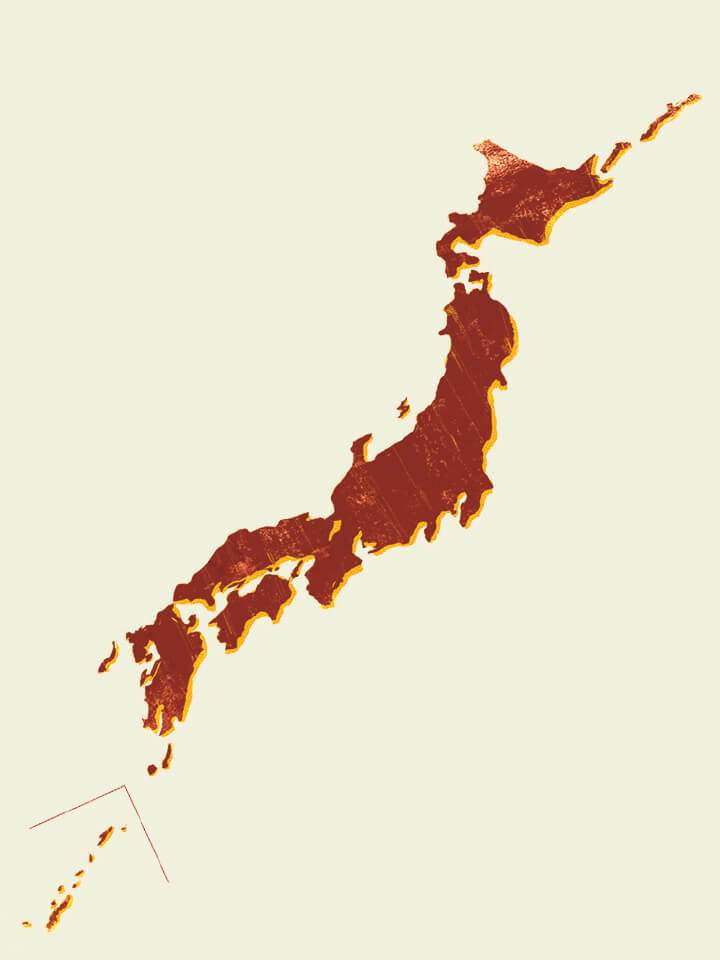
Knowledge: History
History:History of over 1000 years Japanese leather culture

Leather processing cultures vary from ethnic group to ethnic group. This is because the processing method changes depending on the climate, lifestyle, and culture. In the case of continents such as Europe, interaction with neighboring areas often brought about more new techniques.
In the case of Japan, craftsmen called "Jukuhide Goryeo" and "Komabe" who came from the continent introduced the leather processing techniques. In other words, the history of Japanese leather can be traced back more than 1000 years. Leather tanning has been popular in the Banshu Himeji region since that time, and the tanning process is as follows: rawhide treatment with salt from the Seto Inland Sea → rinse in shallow water → soaking in river water → hair removal → salting → humidification → applying rapeseed oil → rubbing → exposing → washing. Himeji, which is near the sea, was a perfect place for leather processing.
Leather was processed using the same technique in other areas as well. Until the Edo period, when Japan opened its doors to other countries, leather was processed using this technique, and leather was valued, used for saddles and book covers. Vegetable tanning and chrome tanning, which are the current mainstream techniques, were introduced in the Meiji era and continue to the present day.
Leather culture 01
Hokkaido is known for its unique climate, especially its harsh winters. What kind of leather has been handed down in that area? In the indigineous Ainu culture that has developed since ancient times, they not only tanned animal skin, but also salmon skin was used for everyday items such as shoes. In the Tohoku region, where there are many horse breeding and ranches since the Asuka period, footwear manufacturing has a history, and even today, the technology is being passed down as a local industry in Yamagata and Fukushima prefectures.
Leather culture 02
Bags have been actively manufactured in Tokyo. Around Asakusa, not only bags but also leather goods factories such as shoes and belts line the streets. In addition, there are many tanning factories in the Kanto area to supply the raw material. Tokyo is especially known for pig leather . There are large rivers such as the Sumida River and Arakawa River, and the land pattern is suitable for leather tanning, and there are many cottage industry size workshops. Additionally, there are many processing factories for exotic leather such as reptiles.
Leather culture 03
Of particular note is the Koshu Inden. It is made of deer leather with a unique pattern, and is characterized by the smooth technique and lacquer processing. It has been used for armor and accessories. Koshu Inden originates from decorative leather from India presented to the Shogunate in the middle of the Edo period. It was manufactured all over the country, but the technique is still passed down to Koshu. With the times, products have changed shape and are now used for bags, and other accessories, and its popularity continues to be strong.
Leather culture 04
Higashikagawa City, where more than 90% of the leather gloves in Japan are made, is located in the Shikoku region. Many of the gloves used by top athletes such in baseball and golf are also made here. Why is the leather industry so prosperous? One reason is the characteristics of the land. The climate and terrain of the region, which is warm, has less rain and has more rivers, thus is suitable for leather processing. World-class Japanese technology can be seen here.
Leather culture 05
The Sanin / Sanyo region is known for its high-quality steel and is known for producing Japanese swords. The handle of the sword and the tomb are decorated with shark skin. However, the “shark” skin used to decorate Japanese swords is actually skin from a "ray". This "ray", which is now used for small items such as wallets, was actually not from the sea near Japan but imported from the South China Sea and the Indian Ocean. Ray leather, which is characterized by a hard round and oval pattern, is perfect for the beauty of Japanese swords.
Leather culture 06
Leather in this area has a long history, and its processing has been done before the Nara period. In particular, Himeji's tanning technique is famous, and the technique and craftsmanship are still being passed down. The number of tanneries stands out from other areas, nearly three times that of Tokyo, which is the second largest producer of adult cowhide. In Himeji, where a large river flows and the sea is nearby, the terrain itself is suitable for leather processing. In addition, because of its beauty and strength, "white tanning", which has been widely used in armor, harnesses and drums, has been considered as a very valuable item, and is one of the most famous leathers of Himeji. Until recently, the tradition was in jeopardy, but there are gradual movements to preserve the technique. Also in Hyogo prefecture is Toyooka, the city of bags. It is said that 70% of Japanese bags are made here. Originating from the production of yanagikouri, or wicker trunks, it also boasts a history of more than 1000 years. It is also famous for having the only "bag housing complex" in Japan.
Leather culture 07
Kyushu has been a gateway to foreign countries since the opening of Japan. From the Middle Ages to the early modern period, civilization was introduced from China. In the early modern period, new technologies that had never existed before came in from Western countries one after another. And it was here that the leather manufacturing method "landed" via the migrants. Kitakyushu, which has been the center area since ancient times, is now known for producing women's footwear. In addition, Kumamoto Prefecture is famous as one of Japan's leading horse breeding areas. The climate is mild, and livestock farming, which is the raw material for leather, is also popular.